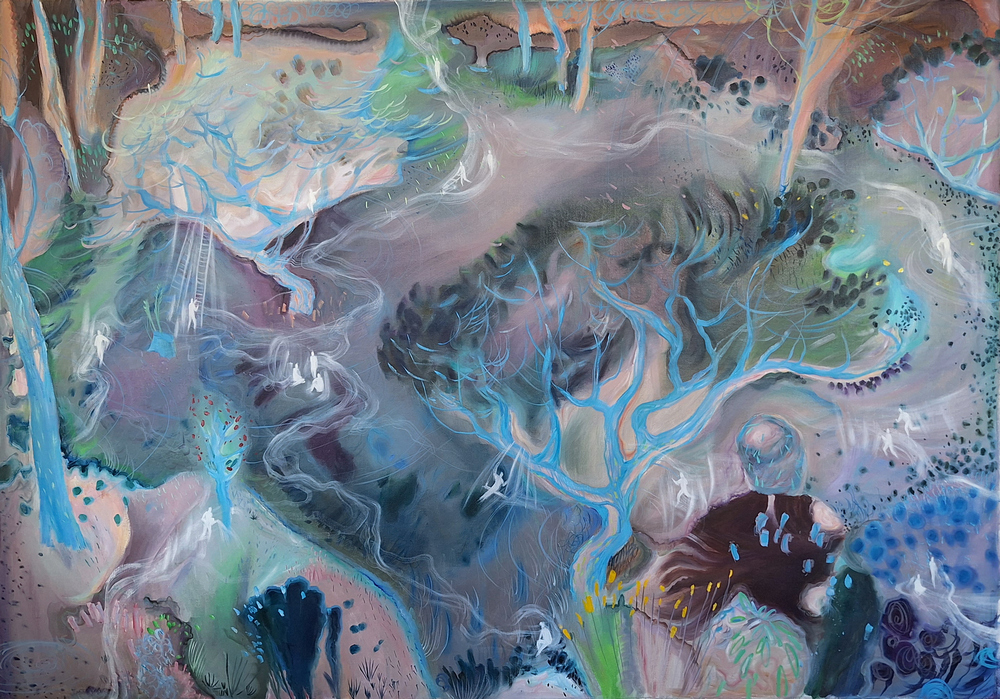Author’s text for my project “Memory of the Garden”
Memory of the Garden
For centuries, nature in art has most often been presented through the prism of human perception. A garden, a forest, a tree or a flower have become metaphors, carriers of emotional states or cultural symbols. But only relatively recently has science begun to consider plants as independent, complex and active participants in the ecosystem; they have their own system of perception and response to the environment, difficult for humans to comprehend. The question arises: can we imagine what we mean to them, how they perceive us?
“Hearing”
Plants do not have ears, but they “hear” the world through vibrations and oscillations. Experiments show that pea roots are drawn to the source of the real sound of running water, distinguishing it from a recorded one. Moreover, plants themselves emit ultrasonic signals that remain indistinguishable to humans, but are audible to other living beings. They become especially “loud” in a state of stress.
“Smell”.
Plants detect odors (volatile organic compounds) through stomata — small pores in leaves — and can produce them themselves. Their “sense of smell” is much slower than ours, because odor molecules must penetrate the cell and accumulate before they affect the plant’s behavior. But it is also incomparably more subtle: one plant can warn another of an impending threat by releasing alarm molecules, and the neighbor activates defense mechanisms even before the attack.
“Touch”
Plants react to touch and pressure through special mechanoreceptors. Roots are able to “feel” the space, avoid obstacles, and react to the presence of other roots. They can slow down growth from too frequent contact, or avoid contact in the crowns of mature trees, creating the phenomenon of a “shy crown.”
Plants react to leaf damage in much the same way as our nervous system to pain, through special signals. Only they spread much more slowly.
“Vision”
Plants perceive a wide spectrum of radiation, beyond the range of human vision. Light affects their growth, color and spatial orientation. Many plants, such as sunflowers, demonstrate heliotropism – they follow the Sun. Moreover, before dawn, they turn in advance towards the future sunrise, which indicates the work of a kind of “memory”.
But here’s the question. Do plants have an individual image of the world around them? There is no clear answer yet. And even if they do, it is definitely not imaginable by humans. We are too different species.
What is our main difference? That billions of years ago, plant and animal cells each chose their own unique survival mechanism. Animal cells learned to move. And plant cells learned to photosynthesize. They did not need to make active movements for nutrition. They went the other way.
We live in different time planes. If a person is hot or cold. He will get up and leave. And the plant will begin to form a root system in the right direction and gradually crawl to where it is better for it.
We can stretch out our hand to get what we need. But a plant will have to grow a branch to get more light.
Almost all signals and reactions in plants occur much slower than in animals and humans. Our movements for them are like a high-speed plane.
That is why the central work of the cycle “Memory of the Garden” depicts human figures as light traces in the night – like fireflies captured in a long exposure photograph. For plants, we are exactly like that: fleeting flashes of high speed, almost tearing apart the fabric of their perception.
The entire structure of plants and all their natural mechanisms are tuned not to react to humans, but to insects, animals, other plants, and natural factors. Apparently, plants were a little uninterested in us. After all, we were not a serious threat to them for a very long time. Until we began to rapidly cut down and destroy not just trees, but entire ecosystems. And with our speeds, they have no chance.
Man is the only creature on the planet that, while being part of an ecosystem, has the ability to completely destroy it – to cut down the branch on which he sits. In this sense, we occupy a truly unique position in the world. We have a choice – to destroy and consume or to create.
The “Memory of the Garden” project is an attempt to present the world from the point of view of plants and at the same time a reminder: we have an exceptional and rare responsibility for the preservation of nature.

Van Luong (1)
 Kjell Zillen (4)
Kjell Zillen (4) Mels Dees (9)
Mels Dees (9) Gao Yu (4)
Gao Yu (4)Katya Lebedev (1)
Juan Dies (1)
 Anastasia Prahova (2)
Anastasia Prahova (2)Nena Nastasiya (7)
Taarn Scott (6)
 Cynthia Fusillo (20)
Cynthia Fusillo (20)Roberta Orlando (8)
 Nanda Raemansky (25)
Nanda Raemansky (25) Eliane Velozo (22)
Eliane Velozo (22)Leyya Mona Tawil (1)
Julia Dubovyk (2)
Jianglong (2)
 Iara Abreu (23)
Iara Abreu (23) Agathe Simon (1)
Agathe Simon (1)Rosetta Allan (1)
Elizaveta Ostapenko (5)
 Valentin Boiangiu (2)
Valentin Boiangiu (2) Wesley John Fourie (9)
Wesley John Fourie (9) Renato Roque (3)
Renato Roque (3)Rosa Gauditano (5)
Neerajj Mittra (34)
Ciana Fitzgerald (5)
Boris Moz (3)
 Katerina Muravuova (5)
Katerina Muravuova (5)Kyla Bernberg (1)
 Muyuan He (1)
Muyuan He (1)Liza Odinokikh (2)
 Amalia Gil-Merino (2)
Amalia Gil-Merino (2)Paulo Carvalho Ferreira (6)
 Anastasiia Komissarova (2)
Anastasiia Komissarova (2) Yumiko Ono (1)
Yumiko Ono (1) Stefania Smolkina (1)
Stefania Smolkina (1)Lena Adasheva (1)
 Zahar Al-Dabbagh (1)
Zahar Al-Dabbagh (1) Emily Orzech (6)
Emily Orzech (6) Fernanda Olivares (5)
Fernanda Olivares (5) Noor van der Brugge (3)
Noor van der Brugge (3) Ira Papadopoulou (2)
Ira Papadopoulou (2) Tom Chambers (8)
Tom Chambers (8) Titi Gutierrez (3)
Titi Gutierrez (3) Franz Wanner (2)
Franz Wanner (2) Crystal Marshall (6)
Crystal Marshall (6) Transpositions III (36)
Transpositions III (36) Riddhi Patel (3)
Riddhi Patel (3) Michele Kishita (2)
Michele Kishita (2)Damian Carlton (4)
 Deanna Sirlin (1)
Deanna Sirlin (1) Laura Salerno (3)
Laura Salerno (3) Nina Annabelle Märkl (12)
Nina Annabelle Märkl (12) Elina Fattakhova (1)
Elina Fattakhova (1) Tasha Hurley (1)
Tasha Hurley (1) Ian Hartley (2)
Ian Hartley (2) Laurence de Valmy (2)
Laurence de Valmy (2) Ilia Bouslakov (5)
Ilia Bouslakov (5) Andrea Ahuactzin Pintos (4)
Andrea Ahuactzin Pintos (4) Sveta Nosova (3)
Sveta Nosova (3)Carlos Carvalho (1)
 Maria Timofeeva (1)
Maria Timofeeva (1) Jinn Bug (2)
Jinn Bug (2) Johannes Gerard (3)
Johannes Gerard (3)Irène Mélix (1)
 Aba Lluch Dalena (3)
Aba Lluch Dalena (3) Fabian Reimann (1)
Fabian Reimann (1)Natalia Gourova (1)
 Kate Finkelstein (4)
Kate Finkelstein (4)Raina Greifer (1)
James McCann (2)
Naza del Rosal Ortiz (1)
 Jay Critchley Jay Critchley (1)
Jay Critchley Jay Critchley (1) Vicky Clarke (4)
Vicky Clarke (4) Maria Silva (4)
Maria Silva (4) Shir Cohen (5)
Shir Cohen (5) Peter Shenai (4)
Peter Shenai (4) Bo Choy (4)
Bo Choy (4)Alina Orlov (2)
 Olga Popova (3)
Olga Popova (3) Coco Spencer (2)
Coco Spencer (2) Filippo Fabbri (2)
Filippo Fabbri (2)Daniele Leonardo (5)
 SISTERS HOPE (1)
SISTERS HOPE (1) Scenocosme : Gregory Lasserre & Anais met den Ancxt (4)
Scenocosme : Gregory Lasserre & Anais met den Ancxt (4) Anne Fehres & Luke Conroy (6)
Anne Fehres & Luke Conroy (6) Olesya Ilenok (2)
Olesya Ilenok (2) Marie-Eve Levasseur (4)
Marie-Eve Levasseur (4) Natalia Tikhonova (2)
Natalia Tikhonova (2)Ildar Iakubov (1)
 Evgeniy Lukuta (7)
Evgeniy Lukuta (7) Jarkko Räsänen (5)
Jarkko Räsänen (5)Maria Guta (6)
Egle Kulbokaite Dorota Gaweda (6)
Thomas Kotik (1)
 Andrea Stanislav (3)
Andrea Stanislav (3)Ludmila Belova (1)
Alena Levina (1)
 Ilia Symphocat (2)
Ilia Symphocat (2)Yevgeniy Fiks (1)
Star Smart(Formerly Trauth) (18)
Jyoti Arvey (1)
Les Joynes (2)
 Ekaterina Ivanova (1)
Ekaterina Ivanova (1) Lev Shusharichev (1)
Lev Shusharichev (1)Michael Stebackov (5)
Ryan Griffith (3)
Lidia Gordeenko (3)
 Masha Danilovskaya (7)
Masha Danilovskaya (7) Irina Korotkaya (2)
Irina Korotkaya (2) WagtailFilms Oksana Bronevitskaia&Dmitry Zhukov (5)
WagtailFilms Oksana Bronevitskaia&Dmitry Zhukov (5)Kostya Diachkov (1)
Elena Sokolova (3)
Alexander Nikolsky (2)

